Report: Analysis of Emerging Issues in Hospitality and Tourism Sector
VerifiedAdded on 2020/05/28
|7
|1731
|80
Report
AI Summary
This report provides a comprehensive analysis of the emerging issues in the hospitality and tourism sectors. It identifies the critical challenge of attracting and retaining a skilled workforce, attributing it to factors such as low wages, long work hours, and a lack of employee satisfaction. The report highlights the impact of demographic shifts and an aging workforce on labor availability. It delves into specific recommendations, including enhanced employee training programs, the development of attractive career paths, and the strategic use of guest worker programs and incentives. Cross-utilization and cross-training of employees are also suggested as vital strategies to address workforce gaps. The report emphasizes the need for industry-wide collaboration to create a more appealing image for the sector, ultimately attracting and retaining a competent workforce.
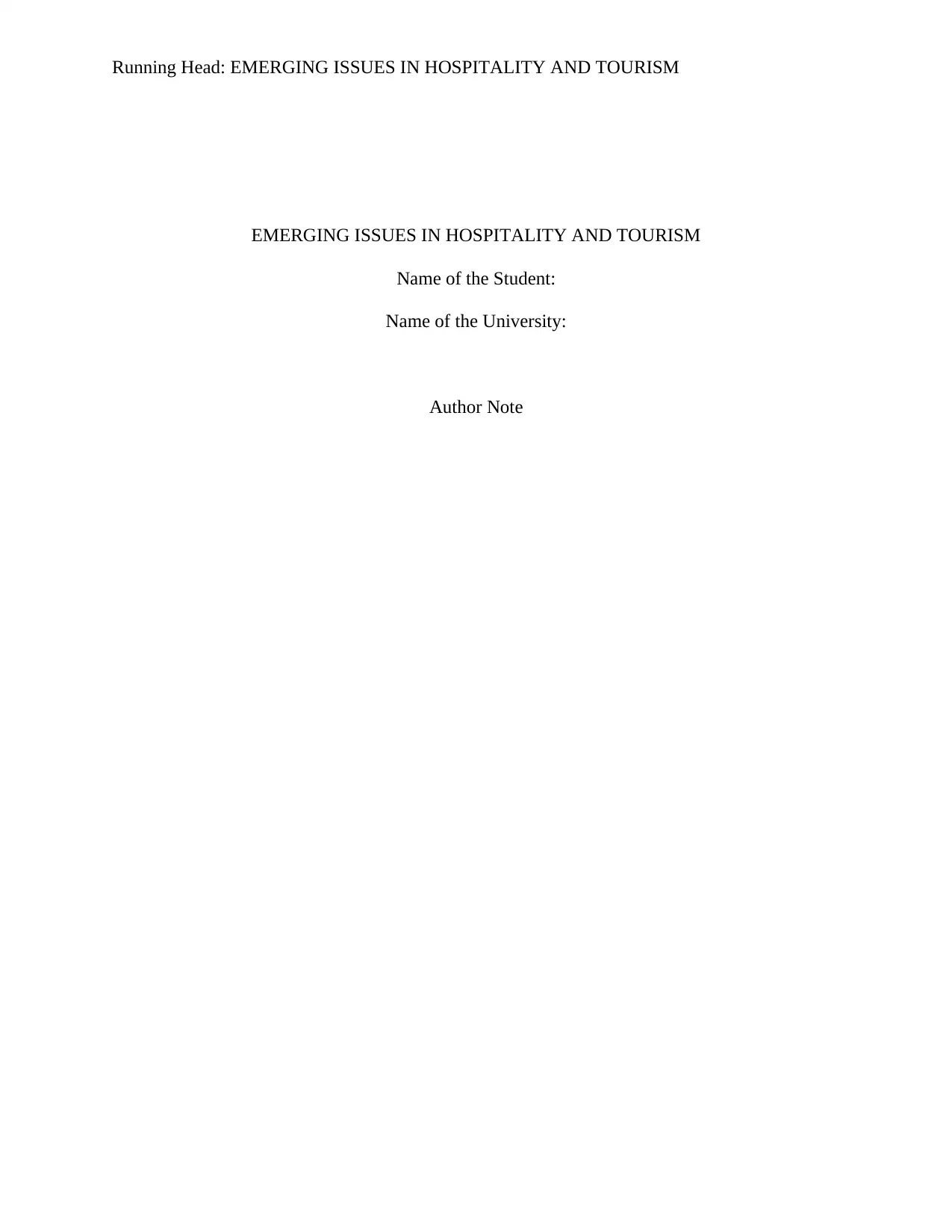
Running Head: EMERGING ISSUES IN HOSPITALITY AND TOURISM
EMERGING ISSUES IN HOSPITALITY AND TOURISM
Name of the Student:
Name of the University:
Author Note
EMERGING ISSUES IN HOSPITALITY AND TOURISM
Name of the Student:
Name of the University:
Author Note
Paraphrase This Document
Need a fresh take? Get an instant paraphrase of this document with our AI Paraphraser
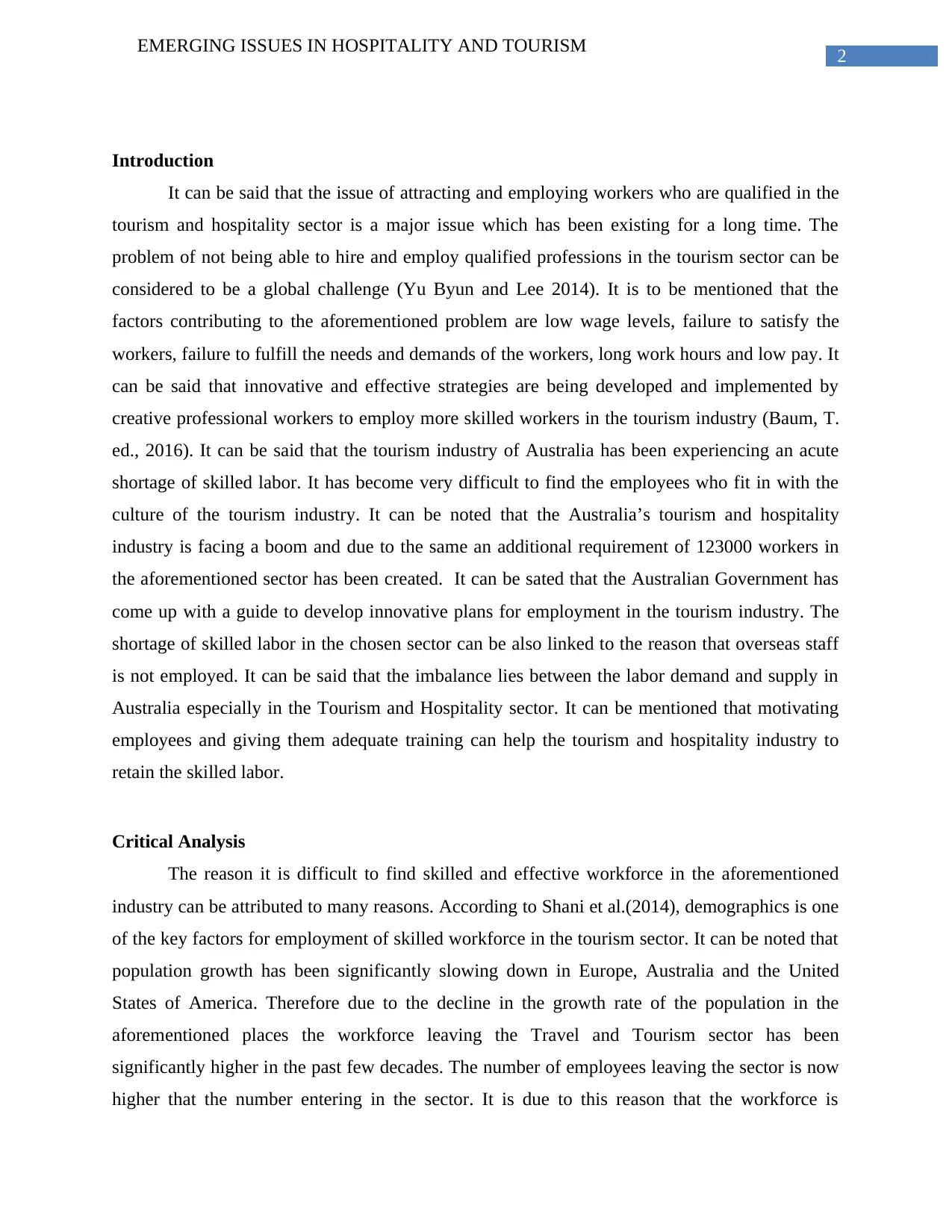
2
EMERGING ISSUES IN HOSPITALITY AND TOURISM
Introduction
It can be said that the issue of attracting and employing workers who are qualified in the
tourism and hospitality sector is a major issue which has been existing for a long time. The
problem of not being able to hire and employ qualified professions in the tourism sector can be
considered to be a global challenge (Yu Byun and Lee 2014). It is to be mentioned that the
factors contributing to the aforementioned problem are low wage levels, failure to satisfy the
workers, failure to fulfill the needs and demands of the workers, long work hours and low pay. It
can be said that innovative and effective strategies are being developed and implemented by
creative professional workers to employ more skilled workers in the tourism industry (Baum, T.
ed., 2016). It can be said that the tourism industry of Australia has been experiencing an acute
shortage of skilled labor. It has become very difficult to find the employees who fit in with the
culture of the tourism industry. It can be noted that the Australia’s tourism and hospitality
industry is facing a boom and due to the same an additional requirement of 123000 workers in
the aforementioned sector has been created. It can be sated that the Australian Government has
come up with a guide to develop innovative plans for employment in the tourism industry. The
shortage of skilled labor in the chosen sector can be also linked to the reason that overseas staff
is not employed. It can be said that the imbalance lies between the labor demand and supply in
Australia especially in the Tourism and Hospitality sector. It can be mentioned that motivating
employees and giving them adequate training can help the tourism and hospitality industry to
retain the skilled labor.
Critical Analysis
The reason it is difficult to find skilled and effective workforce in the aforementioned
industry can be attributed to many reasons. According to Shani et al.(2014), demographics is one
of the key factors for employment of skilled workforce in the tourism sector. It can be noted that
population growth has been significantly slowing down in Europe, Australia and the United
States of America. Therefore due to the decline in the growth rate of the population in the
aforementioned places the workforce leaving the Travel and Tourism sector has been
significantly higher in the past few decades. The number of employees leaving the sector is now
higher that the number entering in the sector. It is due to this reason that the workforce is
EMERGING ISSUES IN HOSPITALITY AND TOURISM
Introduction
It can be said that the issue of attracting and employing workers who are qualified in the
tourism and hospitality sector is a major issue which has been existing for a long time. The
problem of not being able to hire and employ qualified professions in the tourism sector can be
considered to be a global challenge (Yu Byun and Lee 2014). It is to be mentioned that the
factors contributing to the aforementioned problem are low wage levels, failure to satisfy the
workers, failure to fulfill the needs and demands of the workers, long work hours and low pay. It
can be said that innovative and effective strategies are being developed and implemented by
creative professional workers to employ more skilled workers in the tourism industry (Baum, T.
ed., 2016). It can be said that the tourism industry of Australia has been experiencing an acute
shortage of skilled labor. It has become very difficult to find the employees who fit in with the
culture of the tourism industry. It can be noted that the Australia’s tourism and hospitality
industry is facing a boom and due to the same an additional requirement of 123000 workers in
the aforementioned sector has been created. It can be sated that the Australian Government has
come up with a guide to develop innovative plans for employment in the tourism industry. The
shortage of skilled labor in the chosen sector can be also linked to the reason that overseas staff
is not employed. It can be said that the imbalance lies between the labor demand and supply in
Australia especially in the Tourism and Hospitality sector. It can be mentioned that motivating
employees and giving them adequate training can help the tourism and hospitality industry to
retain the skilled labor.
Critical Analysis
The reason it is difficult to find skilled and effective workforce in the aforementioned
industry can be attributed to many reasons. According to Shani et al.(2014), demographics is one
of the key factors for employment of skilled workforce in the tourism sector. It can be noted that
population growth has been significantly slowing down in Europe, Australia and the United
States of America. Therefore due to the decline in the growth rate of the population in the
aforementioned places the workforce leaving the Travel and Tourism sector has been
significantly higher in the past few decades. The number of employees leaving the sector is now
higher that the number entering in the sector. It is due to this reason that the workforce is
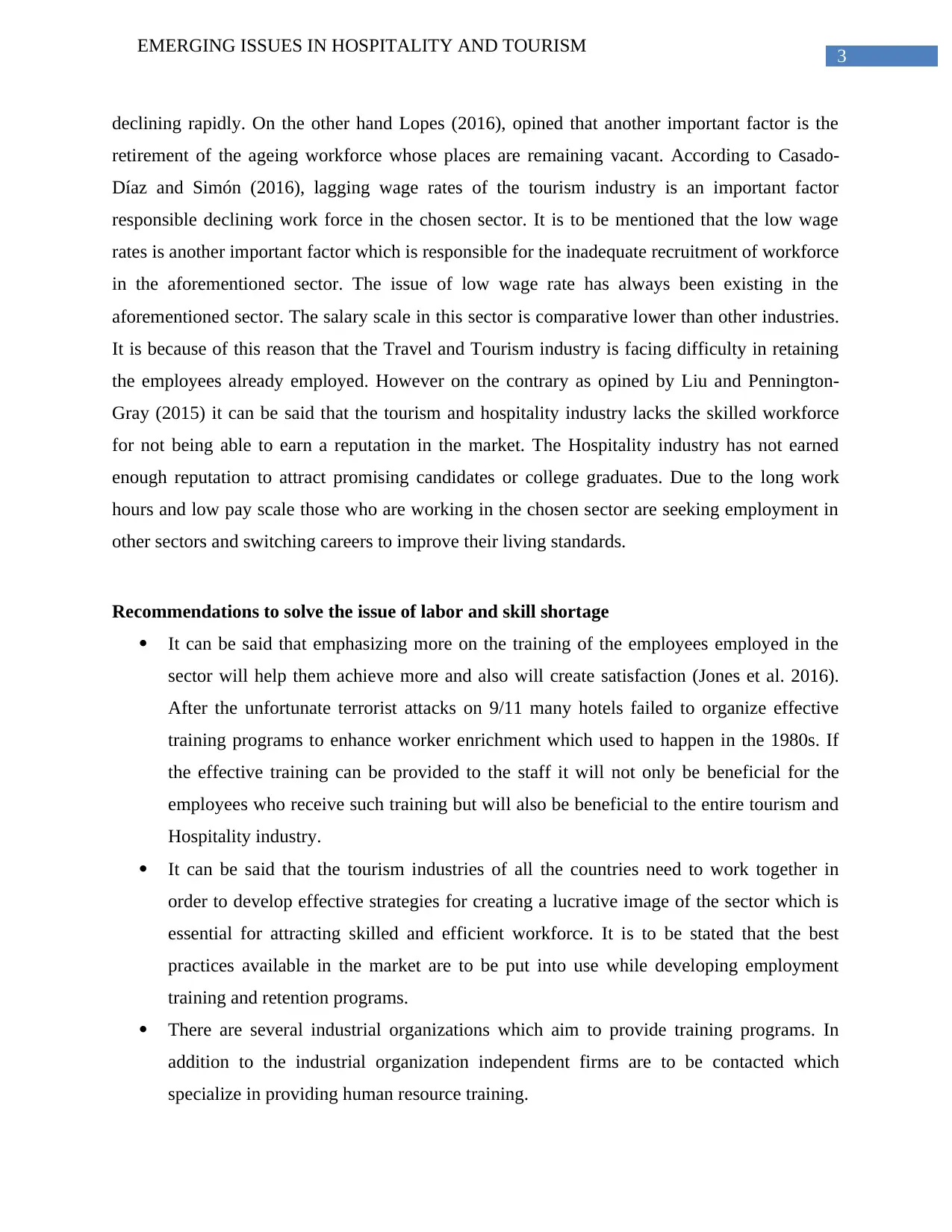
3
EMERGING ISSUES IN HOSPITALITY AND TOURISM
declining rapidly. On the other hand Lopes (2016), opined that another important factor is the
retirement of the ageing workforce whose places are remaining vacant. According to Casado-
Díaz and Simón (2016), lagging wage rates of the tourism industry is an important factor
responsible declining work force in the chosen sector. It is to be mentioned that the low wage
rates is another important factor which is responsible for the inadequate recruitment of workforce
in the aforementioned sector. The issue of low wage rate has always been existing in the
aforementioned sector. The salary scale in this sector is comparative lower than other industries.
It is because of this reason that the Travel and Tourism industry is facing difficulty in retaining
the employees already employed. However on the contrary as opined by Liu and Pennington-
Gray (2015) it can be said that the tourism and hospitality industry lacks the skilled workforce
for not being able to earn a reputation in the market. The Hospitality industry has not earned
enough reputation to attract promising candidates or college graduates. Due to the long work
hours and low pay scale those who are working in the chosen sector are seeking employment in
other sectors and switching careers to improve their living standards.
Recommendations to solve the issue of labor and skill shortage
It can be said that emphasizing more on the training of the employees employed in the
sector will help them achieve more and also will create satisfaction (Jones et al. 2016).
After the unfortunate terrorist attacks on 9/11 many hotels failed to organize effective
training programs to enhance worker enrichment which used to happen in the 1980s. If
the effective training can be provided to the staff it will not only be beneficial for the
employees who receive such training but will also be beneficial to the entire tourism and
Hospitality industry.
It can be said that the tourism industries of all the countries need to work together in
order to develop effective strategies for creating a lucrative image of the sector which is
essential for attracting skilled and efficient workforce. It is to be stated that the best
practices available in the market are to be put into use while developing employment
training and retention programs.
There are several industrial organizations which aim to provide training programs. In
addition to the industrial organization independent firms are to be contacted which
specialize in providing human resource training.
EMERGING ISSUES IN HOSPITALITY AND TOURISM
declining rapidly. On the other hand Lopes (2016), opined that another important factor is the
retirement of the ageing workforce whose places are remaining vacant. According to Casado-
Díaz and Simón (2016), lagging wage rates of the tourism industry is an important factor
responsible declining work force in the chosen sector. It is to be mentioned that the low wage
rates is another important factor which is responsible for the inadequate recruitment of workforce
in the aforementioned sector. The issue of low wage rate has always been existing in the
aforementioned sector. The salary scale in this sector is comparative lower than other industries.
It is because of this reason that the Travel and Tourism industry is facing difficulty in retaining
the employees already employed. However on the contrary as opined by Liu and Pennington-
Gray (2015) it can be said that the tourism and hospitality industry lacks the skilled workforce
for not being able to earn a reputation in the market. The Hospitality industry has not earned
enough reputation to attract promising candidates or college graduates. Due to the long work
hours and low pay scale those who are working in the chosen sector are seeking employment in
other sectors and switching careers to improve their living standards.
Recommendations to solve the issue of labor and skill shortage
It can be said that emphasizing more on the training of the employees employed in the
sector will help them achieve more and also will create satisfaction (Jones et al. 2016).
After the unfortunate terrorist attacks on 9/11 many hotels failed to organize effective
training programs to enhance worker enrichment which used to happen in the 1980s. If
the effective training can be provided to the staff it will not only be beneficial for the
employees who receive such training but will also be beneficial to the entire tourism and
Hospitality industry.
It can be said that the tourism industries of all the countries need to work together in
order to develop effective strategies for creating a lucrative image of the sector which is
essential for attracting skilled and efficient workforce. It is to be stated that the best
practices available in the market are to be put into use while developing employment
training and retention programs.
There are several industrial organizations which aim to provide training programs. In
addition to the industrial organization independent firms are to be contacted which
specialize in providing human resource training.
⊘ This is a preview!⊘
Do you want full access?
Subscribe today to unlock all pages.

Trusted by 1+ million students worldwide
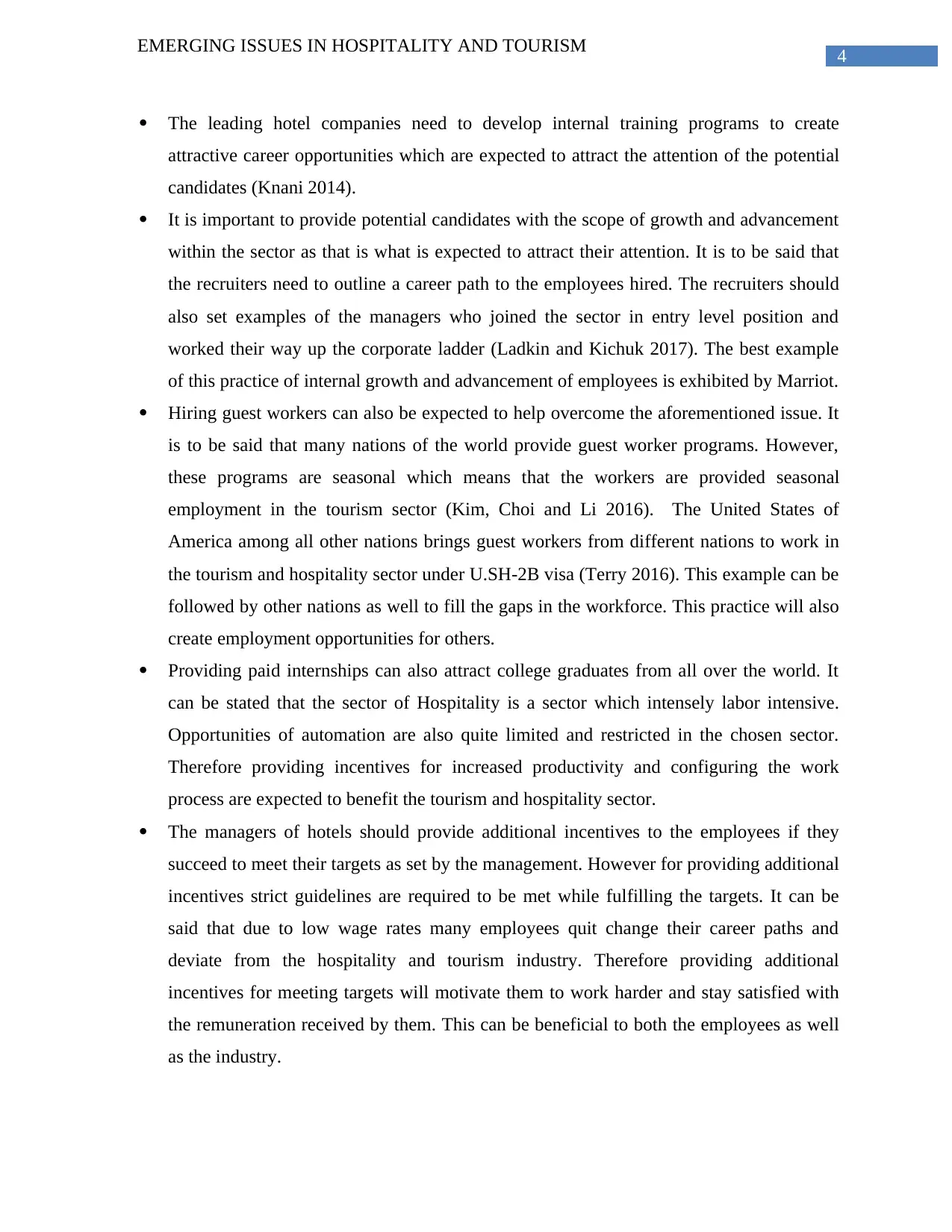
4
EMERGING ISSUES IN HOSPITALITY AND TOURISM
The leading hotel companies need to develop internal training programs to create
attractive career opportunities which are expected to attract the attention of the potential
candidates (Knani 2014).
It is important to provide potential candidates with the scope of growth and advancement
within the sector as that is what is expected to attract their attention. It is to be said that
the recruiters need to outline a career path to the employees hired. The recruiters should
also set examples of the managers who joined the sector in entry level position and
worked their way up the corporate ladder (Ladkin and Kichuk 2017). The best example
of this practice of internal growth and advancement of employees is exhibited by Marriot.
Hiring guest workers can also be expected to help overcome the aforementioned issue. It
is to be said that many nations of the world provide guest worker programs. However,
these programs are seasonal which means that the workers are provided seasonal
employment in the tourism sector (Kim, Choi and Li 2016). The United States of
America among all other nations brings guest workers from different nations to work in
the tourism and hospitality sector under U.SH-2B visa (Terry 2016). This example can be
followed by other nations as well to fill the gaps in the workforce. This practice will also
create employment opportunities for others.
Providing paid internships can also attract college graduates from all over the world. It
can be stated that the sector of Hospitality is a sector which intensely labor intensive.
Opportunities of automation are also quite limited and restricted in the chosen sector.
Therefore providing incentives for increased productivity and configuring the work
process are expected to benefit the tourism and hospitality sector.
The managers of hotels should provide additional incentives to the employees if they
succeed to meet their targets as set by the management. However for providing additional
incentives strict guidelines are required to be met while fulfilling the targets. It can be
said that due to low wage rates many employees quit change their career paths and
deviate from the hospitality and tourism industry. Therefore providing additional
incentives for meeting targets will motivate them to work harder and stay satisfied with
the remuneration received by them. This can be beneficial to both the employees as well
as the industry.
EMERGING ISSUES IN HOSPITALITY AND TOURISM
The leading hotel companies need to develop internal training programs to create
attractive career opportunities which are expected to attract the attention of the potential
candidates (Knani 2014).
It is important to provide potential candidates with the scope of growth and advancement
within the sector as that is what is expected to attract their attention. It is to be said that
the recruiters need to outline a career path to the employees hired. The recruiters should
also set examples of the managers who joined the sector in entry level position and
worked their way up the corporate ladder (Ladkin and Kichuk 2017). The best example
of this practice of internal growth and advancement of employees is exhibited by Marriot.
Hiring guest workers can also be expected to help overcome the aforementioned issue. It
is to be said that many nations of the world provide guest worker programs. However,
these programs are seasonal which means that the workers are provided seasonal
employment in the tourism sector (Kim, Choi and Li 2016). The United States of
America among all other nations brings guest workers from different nations to work in
the tourism and hospitality sector under U.SH-2B visa (Terry 2016). This example can be
followed by other nations as well to fill the gaps in the workforce. This practice will also
create employment opportunities for others.
Providing paid internships can also attract college graduates from all over the world. It
can be stated that the sector of Hospitality is a sector which intensely labor intensive.
Opportunities of automation are also quite limited and restricted in the chosen sector.
Therefore providing incentives for increased productivity and configuring the work
process are expected to benefit the tourism and hospitality sector.
The managers of hotels should provide additional incentives to the employees if they
succeed to meet their targets as set by the management. However for providing additional
incentives strict guidelines are required to be met while fulfilling the targets. It can be
said that due to low wage rates many employees quit change their career paths and
deviate from the hospitality and tourism industry. Therefore providing additional
incentives for meeting targets will motivate them to work harder and stay satisfied with
the remuneration received by them. This can be beneficial to both the employees as well
as the industry.
Paraphrase This Document
Need a fresh take? Get an instant paraphrase of this document with our AI Paraphraser
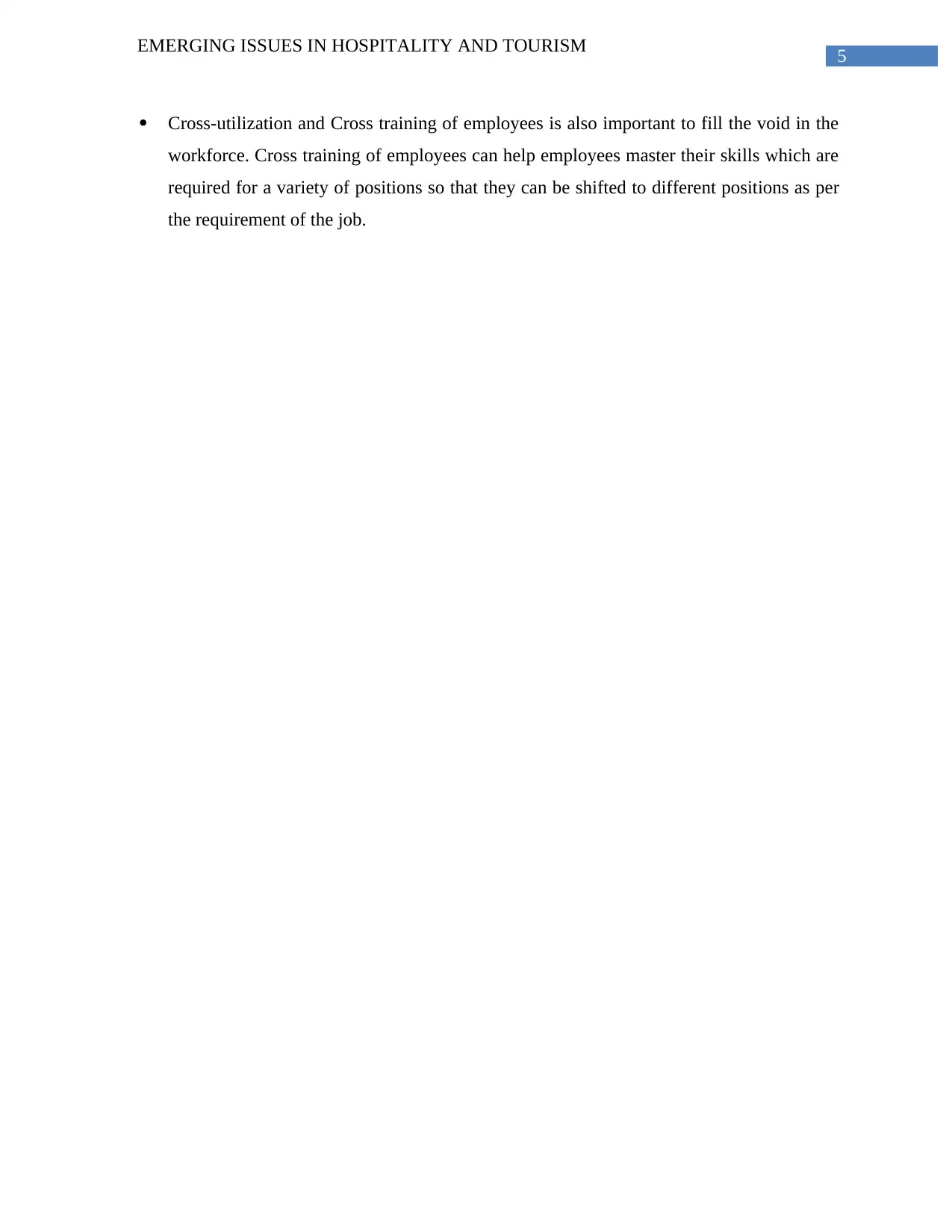
5
EMERGING ISSUES IN HOSPITALITY AND TOURISM
Cross-utilization and Cross training of employees is also important to fill the void in the
workforce. Cross training of employees can help employees master their skills which are
required for a variety of positions so that they can be shifted to different positions as per
the requirement of the job.
EMERGING ISSUES IN HOSPITALITY AND TOURISM
Cross-utilization and Cross training of employees is also important to fill the void in the
workforce. Cross training of employees can help employees master their skills which are
required for a variety of positions so that they can be shifted to different positions as per
the requirement of the job.
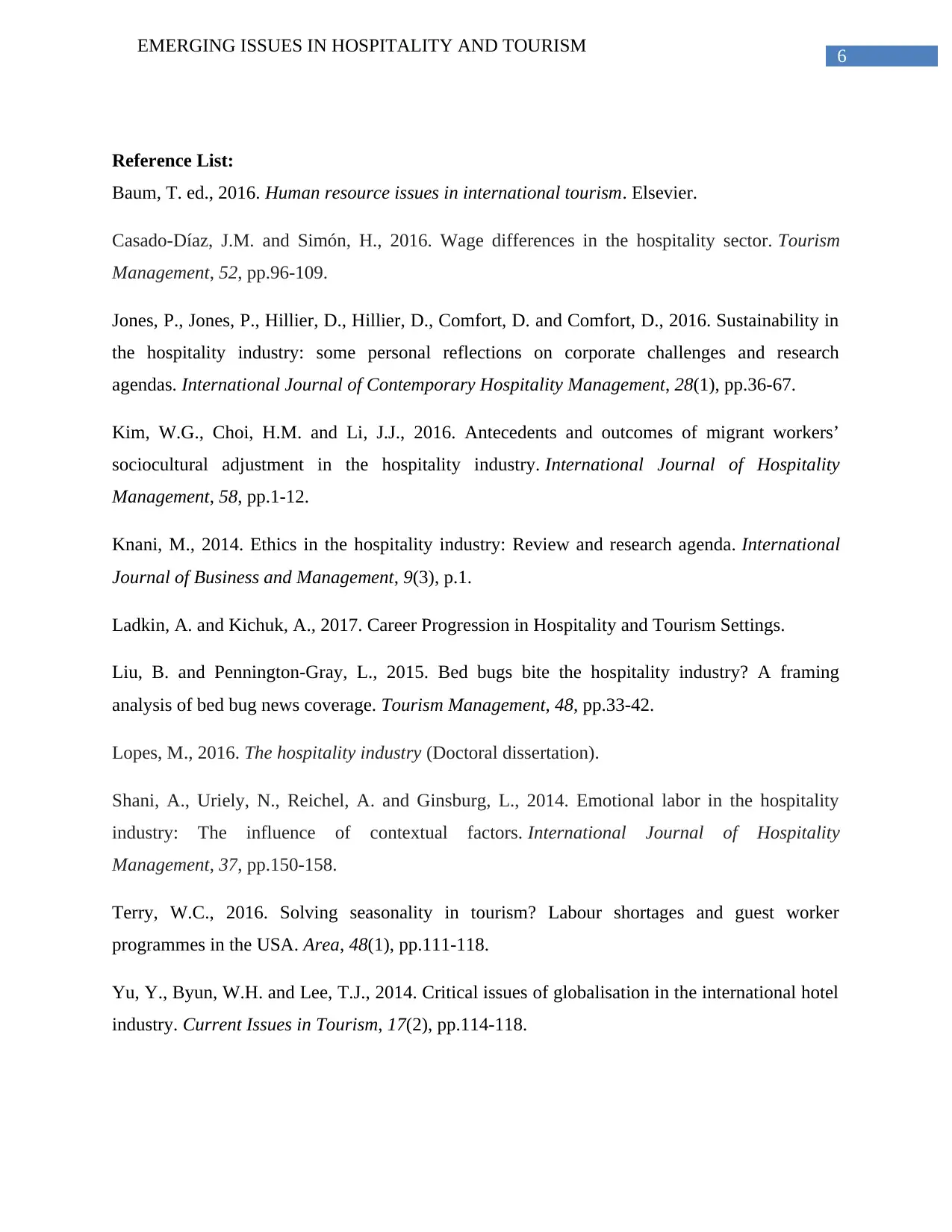
6
EMERGING ISSUES IN HOSPITALITY AND TOURISM
Reference List:
Baum, T. ed., 2016. Human resource issues in international tourism. Elsevier.
Casado-Díaz, J.M. and Simón, H., 2016. Wage differences in the hospitality sector. Tourism
Management, 52, pp.96-109.
Jones, P., Jones, P., Hillier, D., Hillier, D., Comfort, D. and Comfort, D., 2016. Sustainability in
the hospitality industry: some personal reflections on corporate challenges and research
agendas. International Journal of Contemporary Hospitality Management, 28(1), pp.36-67.
Kim, W.G., Choi, H.M. and Li, J.J., 2016. Antecedents and outcomes of migrant workers’
sociocultural adjustment in the hospitality industry. International Journal of Hospitality
Management, 58, pp.1-12.
Knani, M., 2014. Ethics in the hospitality industry: Review and research agenda. International
Journal of Business and Management, 9(3), p.1.
Ladkin, A. and Kichuk, A., 2017. Career Progression in Hospitality and Tourism Settings.
Liu, B. and Pennington-Gray, L., 2015. Bed bugs bite the hospitality industry? A framing
analysis of bed bug news coverage. Tourism Management, 48, pp.33-42.
Lopes, M., 2016. The hospitality industry (Doctoral dissertation).
Shani, A., Uriely, N., Reichel, A. and Ginsburg, L., 2014. Emotional labor in the hospitality
industry: The influence of contextual factors. International Journal of Hospitality
Management, 37, pp.150-158.
Terry, W.C., 2016. Solving seasonality in tourism? Labour shortages and guest worker
programmes in the USA. Area, 48(1), pp.111-118.
Yu, Y., Byun, W.H. and Lee, T.J., 2014. Critical issues of globalisation in the international hotel
industry. Current Issues in Tourism, 17(2), pp.114-118.
EMERGING ISSUES IN HOSPITALITY AND TOURISM
Reference List:
Baum, T. ed., 2016. Human resource issues in international tourism. Elsevier.
Casado-Díaz, J.M. and Simón, H., 2016. Wage differences in the hospitality sector. Tourism
Management, 52, pp.96-109.
Jones, P., Jones, P., Hillier, D., Hillier, D., Comfort, D. and Comfort, D., 2016. Sustainability in
the hospitality industry: some personal reflections on corporate challenges and research
agendas. International Journal of Contemporary Hospitality Management, 28(1), pp.36-67.
Kim, W.G., Choi, H.M. and Li, J.J., 2016. Antecedents and outcomes of migrant workers’
sociocultural adjustment in the hospitality industry. International Journal of Hospitality
Management, 58, pp.1-12.
Knani, M., 2014. Ethics in the hospitality industry: Review and research agenda. International
Journal of Business and Management, 9(3), p.1.
Ladkin, A. and Kichuk, A., 2017. Career Progression in Hospitality and Tourism Settings.
Liu, B. and Pennington-Gray, L., 2015. Bed bugs bite the hospitality industry? A framing
analysis of bed bug news coverage. Tourism Management, 48, pp.33-42.
Lopes, M., 2016. The hospitality industry (Doctoral dissertation).
Shani, A., Uriely, N., Reichel, A. and Ginsburg, L., 2014. Emotional labor in the hospitality
industry: The influence of contextual factors. International Journal of Hospitality
Management, 37, pp.150-158.
Terry, W.C., 2016. Solving seasonality in tourism? Labour shortages and guest worker
programmes in the USA. Area, 48(1), pp.111-118.
Yu, Y., Byun, W.H. and Lee, T.J., 2014. Critical issues of globalisation in the international hotel
industry. Current Issues in Tourism, 17(2), pp.114-118.
⊘ This is a preview!⊘
Do you want full access?
Subscribe today to unlock all pages.

Trusted by 1+ million students worldwide

7
EMERGING ISSUES IN HOSPITALITY AND TOURISM
EMERGING ISSUES IN HOSPITALITY AND TOURISM
1 out of 7
Related Documents
Your All-in-One AI-Powered Toolkit for Academic Success.
+13062052269
info@desklib.com
Available 24*7 on WhatsApp / Email
![[object Object]](/_next/static/media/star-bottom.7253800d.svg)
Unlock your academic potential
Copyright © 2020–2025 A2Z Services. All Rights Reserved. Developed and managed by ZUCOL.




